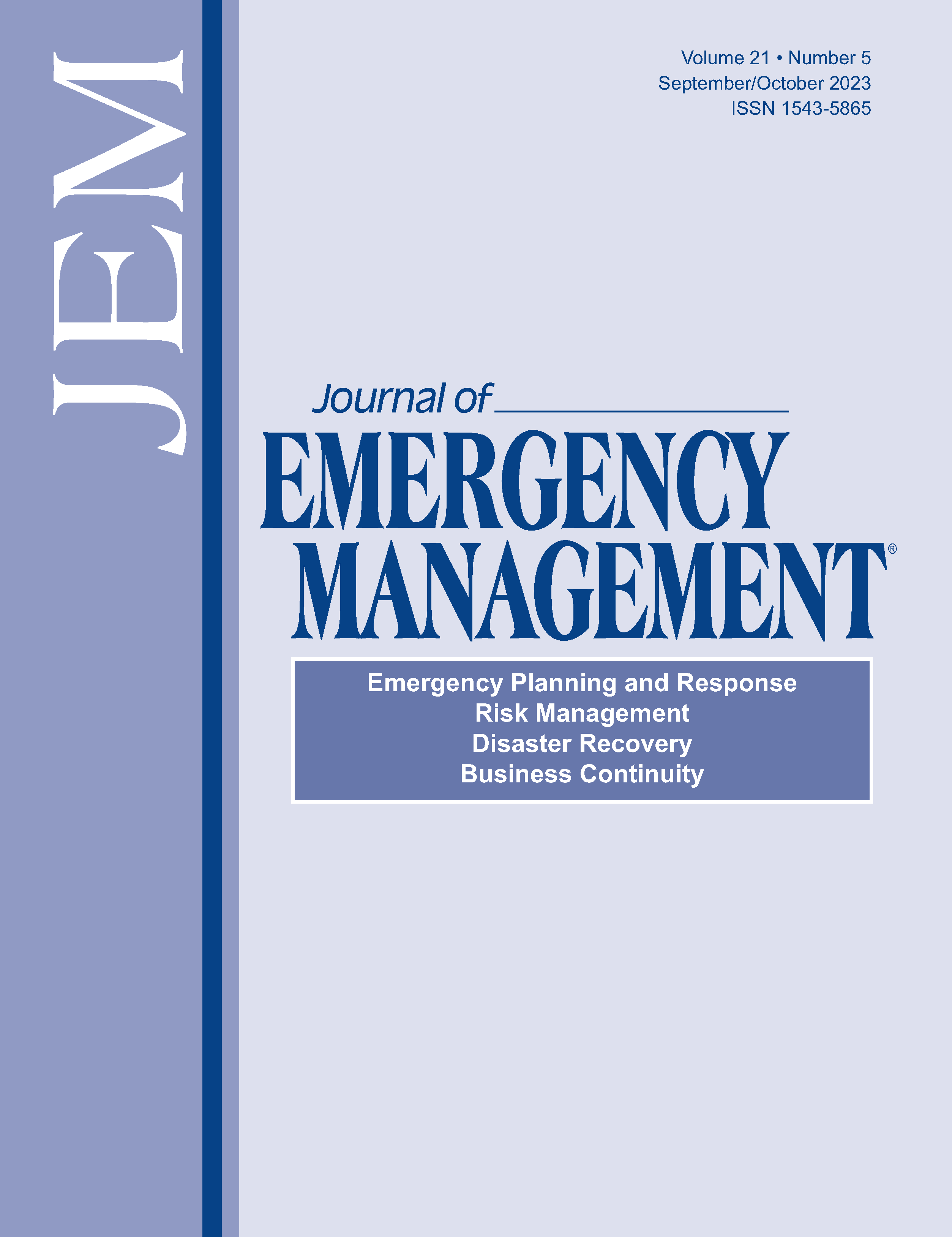Protecting health facilities during wars in the COVID-19 era: A case study of the Indonesian Hospital in the Gaza Strip in the Palestinian Territories
DOI:
https://doi.org/10.5055/jem.0793Keywords:
Gaza Strip, Indonesian Hospital, war 2021, coronavirus disease 2019Abstract
This case study aimed at assessing the impact of the May 2021 War on medical personnel who worked during the coronavirus pandemic. This study was conducted at the Indonesian Hospital in the northern Gaza Strip. This case study included a sample of 391 participants. Of these participants, 100 employees of the Indonesian Hospital were selected randomly. The results revealed that the war has affected social distancing practices and adherence to health guidelines related to the pandemic, an impossible luxury to a large degree, with a mean rate of 4.54. There was a sharp shortage of medical supplies and medicines that have been affected by the war, which in turn affected the treatment of patients with coronavirus with a mean rate of 4.54. In addition, the medical staff faced mild exposure to gases due to military actions, with a mean rate of 3.78. This study recommended that vulnerable countries should be protected under the International Humanitarian Law and be given the necessity of respecting and protecting healthcare. In addition, the denial of medical treatment may be considered cruel or inhumane behavior and an affront to human dignity, constituting war crimes as grave breaches of the Geneva Conventions.
References
Palestinian Central Bureau of Statistics: Estimated population in Palestine mid-year by governorate, 1997-2021. 2021. Available at https://www.pcbs.gov.ps/Portals/_Rainbow/Documents. Accessed January 21, 2022.
Musalam AM, El-Ashgar NM, Al-Agha M, et al.: Sheltering and quarantine measures for risks that threaten the village of umm al-Nasr, Gaza Strip. J Emerg Manag. 2021; 18(7): 127-139.
Salah M, El-Ashgar N, Musalam A, et al.: The effectiveness of coordination between the red crescent and governmental hospitals from the employees perspective. PTURJ. 2021; 9(3): 30-47.
World Health Organization: The World Health Report 2006: Working Together for Health. Geneva: World Health Organization, 2006.
OCHA: Overview. 2021. Available at https://www.ochaopt.org/content/overview-november-2021. Accessed January 21, 2022.
Arab NGO Network for Development: The deterioration of the humanitarian situation in the Gaza Strip during the Israeli war. 2021. Available at https://www.annd.org/ar/publications/details. Accessed January 21, 2022.
The Palestinian Information Center: Indonesian hospital harsh night under the bombing. 2021. Available at https://www.palinfo.net/news/. Accessed January 24, 2022.
Palestinian Ministry of Health: 24 health facilities were damaged. 2021. Available at https://www.moh.gov.ps/portal. Accessed January 24, 2022.
Eisinga R, Te Grotenhuis M, Pelzer B: The reliability of a two-item scale: Pearson, Cronbach or Spearman-Brown? Int J Public Health. 2013; 58(4): 637-642.
Burton A, McKinlay A, Dawes J, et al.: Understanding barriers and facilitators to compliance with UK social distancing guidelines during the COVID-19 pandemic: A qualitative interview study. Behav. Change. 2023; 40(1): 30-50.
Sowers J, Weinthal E: Humanitarian challenges and the targeting of civilian infrastructure in the Yemen war. Int Affairs. 2021; 97(1): 157-177.
Al-Waheidi S, Sullivan R, Davies EA: Additional challenges faced by cancer patients in Gaza due to COVID-19. eCancer. 2020; 14: ed100.
Musalam AM, Abunamous RE, El-Ashgar NM, et al.: Emergency management to avoid the spread of the COVID-19 pandemic in Gaza Strip. Health Planning Manag. 2021; 36(5): 1742-1757.
Daw MA: The impact of armed conflict on the epidemiological situation of coronavirus disease (COVID-19) in Libya, Syria, and Yemen. Front Public Health. 2021; 9: 698.
Musalam A, Abuhabib A, Salah M: Emergency management requirements to overcome the crises of Umm al-Nasr. ANUJR B. 2019; 33(3): 5.
Ilczak T, Rak M, C´ wiertnia M, et al.: Predictors of stress among emergency medical personnel during the COVID-19 pandemic. Int J Occup Med Environ Health. 2021; 34(2): 139-149.
Okumura T, Hisaoka T, Yamada A, et al.: The Tokyo subway sarin attack—Lessons learned. Toxicol Appl Pharmacol. 2005; 207(2): 471-476.
Ehrlich H, McKenney M, Elkbuli A: Protecting our healthcare workers during the COVID-19 pandemic. Am J Emerg Med. 2020; 38(7): 1527-1528.
Musalam AM, El-Ashgar NM, Al-Agha M, et al.: Emergency management during wars: Case study “umm Al-Nasr village” Bedouin village. J Emerg Med. 2020; 18(4): 311-323.
Prideaux B: The need to use disaster planning frameworks to respond to major tourism disasters: Analysis of Australia’s response to tourism disasters in 2001. J Travel Tourism Market. 2004; 15(4): 281-298.
Goniewicz K, Goniewicz M, Włoszczak-Szubzda A, et al.: The importance of pre-training gap analyses and the identification of competencies and skill requirements of medical personnel for mass casualty incidents and disaster training. BMC Public Health. 2021; 21(1): 1-11.
Li M, Zhang C, Ding M, et al.: A two-stage stochastic variational inequality model for storage and dynamic distribution of medical supplies in epidemic management. Appl Math Model. 2022; 102: 35-61.
Melnychuk E, Sallade TD, Kraus CK: Hospitals as disaster victims: Lessons not learned? JACEP Open. 2022; 3(1): e12632.
Belhouideg S: Impact of 3D printed medical equipment on the management of the COVID-19 pandemic. Int J Health Plann Manag. 2020; 35(5): 1014-1022.
Zangrillo A, Beretta L, Silvani P, et al.: Fast reshaping of intensive care unit facilities in a large metropolitan hospital in Milan, Italy: Facing the COVID-19 pandemic emergency. CC&R. 2020; 22(2): 91-94.
Rencher AC, Christensen WF: Multivariate regression—Section 10.1, Introduction (Chapter 10). In Methods of Multivariate Analysis (3rd ed., vol. 709). Hoboken, NJ: John Wiley & Sons, 2012: 19.
Published
How to Cite
Issue
Section
License
Copyright 2007-2025, Weston Medical Publishing, LLC and Journal of Emergency Management. All Rights Reserved.
Leave Nobody Behind: Emergency Management in a More Inclusive Way is a trademark of Journal of Emergency Management






